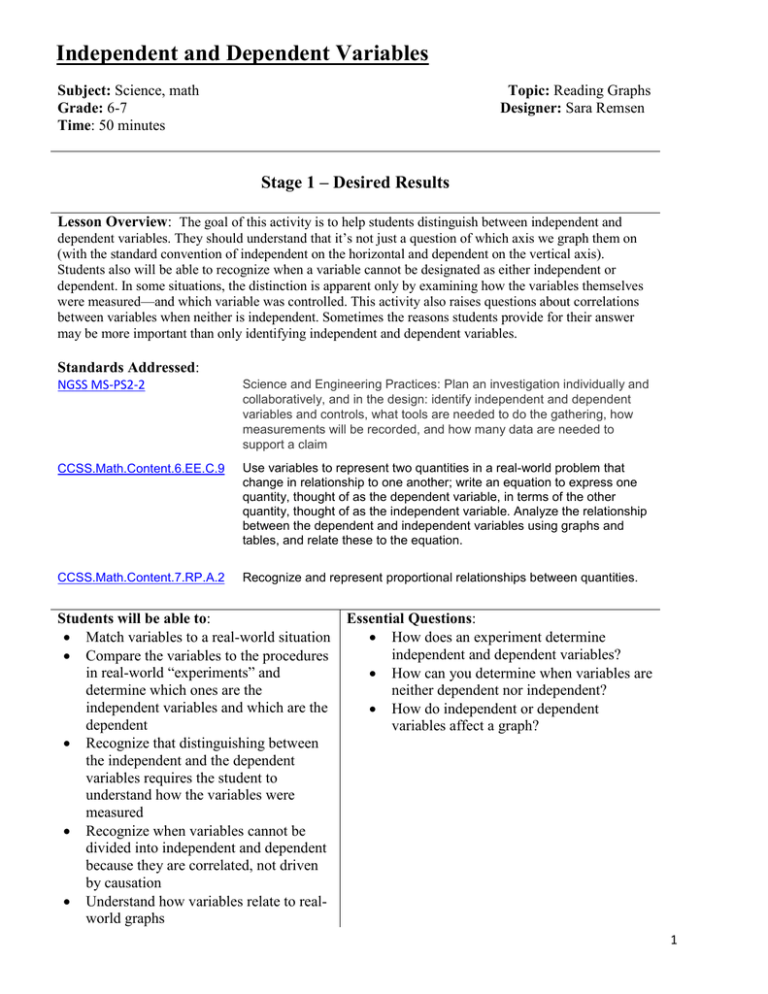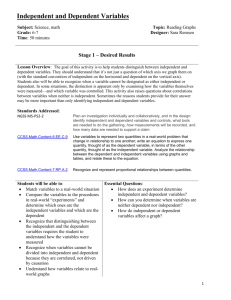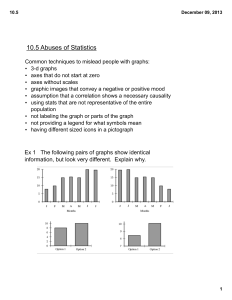Independent and Dependent Variables
advertisement

Independent and Dependent Variables Subject: Science, math Grade: 6-7 Time: 50 minutes Topic: Reading Graphs Designer: Sara Remsen Stage 1 – Desired Results Lesson Overview: The goal of this activity is to help students distinguish between independent and dependent variables. They should understand that it’s not just a question of which axis we graph them on (with the standard convention of independent on the horizontal and dependent on the vertical axis). Students also will be able to recognize when a variable cannot be designated as either independent or dependent. In some situations, the distinction is apparent only by examining how the variables themselves were measured—and which variable was controlled. This activity also raises questions about correlations between variables when neither is independent. Sometimes the reasons students provide for their answer may be more important than only identifying independent and dependent variables. Standards Addressed: NGSS MS-PS2-2 Science and Engineering Practices: Plan an investigation individually and collaboratively, and in the design: identify independent and dependent variables and controls, what tools are needed to do the gathering, how measurements will be recorded, and how many data are needed to support a claim CCSS.Math.Content.6.EE.C.9 Use variables to represent two quantities in a real-world problem that change in relationship to one another; write an equation to express one quantity, thought of as the dependent variable, in terms of the other quantity, thought of as the independent variable. Analyze the relationship between the dependent and independent variables using graphs and tables, and relate these to the equation. CCSS.Math.Content.7.RP.A.2 Recognize and represent proportional relationships between quantities. Students will be able to: • Match variables to a real-world situation • Compare the variables to the procedures in real-world “experiments” and determine which ones are the independent variables and which are the dependent • Recognize that distinguishing between the independent and the dependent variables requires the student to understand how the variables were measured • Recognize when variables cannot be divided into independent and dependent because they are correlated, not driven by causation • Understand how variables relate to realworld graphs Essential Questions: • How does an experiment determine independent and dependent variables? • How can you determine when variables are neither dependent nor independent? • How do independent or dependent variables affect a graph? 1 Stage 2 – Lesson Plan Lesson preparation • Students should be familiar with plotting points on a graph and with ordered pairs i.e. (0,0). • Students should be able to read graph axes. • Students should understand the concept of a variable. • Students should have been introduced to the concept of independent and dependent variables. • Students should have a very basic knowledge of experimental design (as simple as “change something and then measure some response”). • No knowledge of slope or the nature of hypotheses is necessary. Procedure 1. Students will use computers/tablets for this activity (20-30 minutes). 2. As an introduction, you can collect height and weights from each student (or height and finger length—anything continuous). This can serve as an introduction to independent and dependent variables. 3. As a post-activity extension, you can have students create their own scenarios with a multiple-choice question and an explain box. Students can then trade with a partner and then discuss. This will probably raise various issues for the entire class. 4. This activity can be followed up with a discussion about graphing independent and dependent variables. You can collect more data from the class and ask them to choose which is the dependent variable and which in the independent variable and how they would assign them to axes, etc. Further discussion questions 1. How did you know when a variable was independent or dependent? There will be a range of answers, but students should notice that there is generally one variable that is manipulated or is consistent (time or angle of a ramp) and one variable that they measure based on the change (miles or distance of the toy car) 2. Why are some variables neither “independent” nor “dependent”? Some variables are correlated, like height and weight. In this case, being taller probably means you weigh more but if you weigh more, chances are you are taller too. In the case of these variables, they are probably both dependent on another variable like nutrition (with more nutrition, height and weight would increase). (In that case, the next question might be “how do you measure nutrition?”) 3. If you are a scientist designing an experiment, how will you determine your independent or dependent variable? Students should say that their independent variable would be time or something they would change—they want to see the effect of the independent variable on the dependent variable. You can then ask them how they would graph it and why. 2

